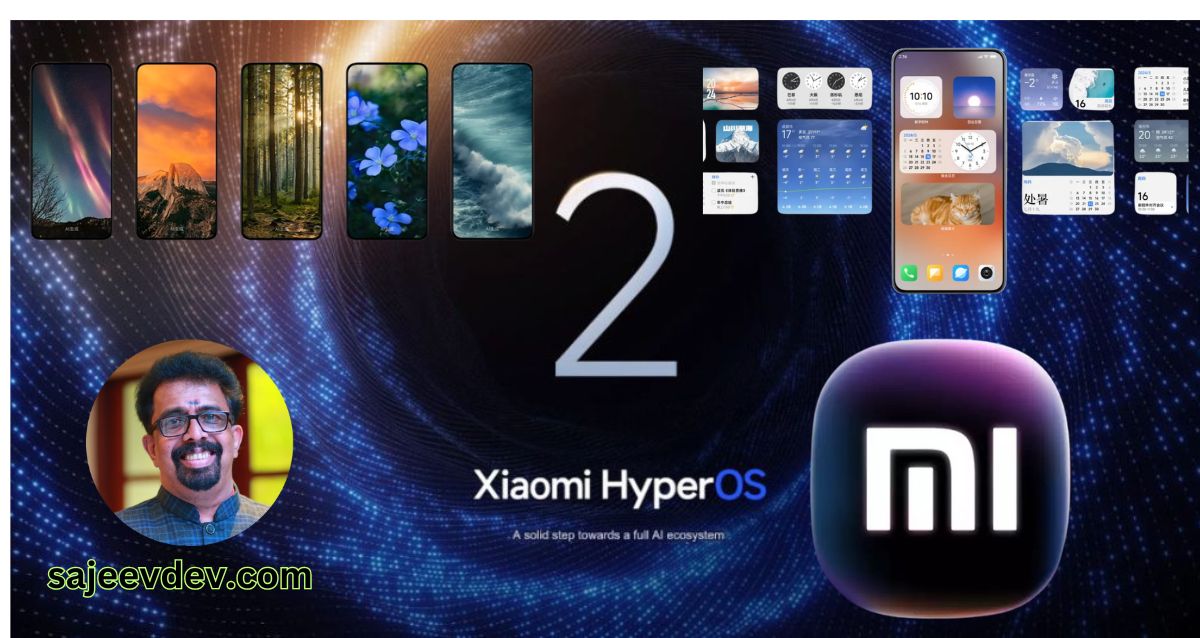Xiaomi HyperOS 2
Xiaomi has recently unveiled its latest operating system, HyperOS 2, marking a significant milestone in the company’s software evolution. This announcement coincides with the launch of the Xiaomi 15 series in China, indicating the company’s commitment to enhancing the user experience across its ecosystem. HyperOS 2 is poised to redefine the way users interact with their devices, showcasing a blend of innovative features and a user-friendly interface designed to cater to the diverse needs of Xiaomi customers.
The introduction of HyperOS 2 reflects Xiaomi’s broader strategy to integrate its software and hardware more seamlessly. It aims to provide a unified experience across various devices, including smartphones, tablets, and smart home products. This holistic approach is intended to improve functionality while ensuring that users can enjoy a consistent interface and performance, regardless of the device they are using within the Xiaomi ecosystem.
Moreover, HyperOS 2 builds upon the foundations laid by its predecessor, introducing enhancements in speed, efficiency, and security. The new operating system is equipped with features that leverage artificial intelligence to optimize device performance, thereby allowing users to achieve their tasks more effectively. Additionally, this operating system promises improved multitasking capabilities, enhanced app management, and a more personalized experience that can adapt to the unique preferences of each user.
The significance of HyperOS 2 cannot be overstated, as it not only elevates Xiaomi’s software offerings but also strengthens its position against competitors in the tech industry. As the digital landscape continues to evolve, this operating system positions Xiaomi to meet the increasing demands for smarter, more integrated technological solutions. Ultimately, the rollout of HyperOS 2 represents a pivotal moment for the future of Xiaomi’s software and its impact on users worldwide.
Key Innovations in HyperOS 2
Xiaomi’s recently announced HyperOS 2 is a notable advancement in their software ecosystem, introducing three primary innovations: Hypercore, Hyperconnect, and HyperAI. Each of these elements serves to enhance the user experience significantly and reflects Xiaomi’s commitment to creating an interconnected environment for its devices.
Hypercore forms the foundational architecture of HyperOS 2, designed to optimize performance and efficiency across various devices. By leveraging a modular design, Hypercore ensures that tasks are allocated in a way that maximizes processing power while reducing latency. This architecture is not only designed to function on smartphones, but also aims to improve the overall performance of tablets, smart TVs, and IoT devices, allowing for a seamless transition between them. With Hypercore, users can expect faster boot times, enhanced multitasking capabilities, and an overall smoother experience.
Next, Hyperconnect embodies Xiaomi’s vision of a truly interconnected ecosystem. This innovation focuses on streamlining connectivity between devices, creating a cohesive user experience regardless of the platform. With Hyperconnect, users can easily switch between their smartphones and smart home devices, accessing data and features with minimal friction. Enhanced features like synchronized notifications and streamlined file sharing capabilities allow for an integrated approach that simplifies daily tasks. Users will find that Hyperconnect not only saves time but also enriches their interaction with different devices in their environment.
Finally, HyperAI represents a significant leap forward in artificial intelligence integration within the Xiaomi framework. This feature aims to personalize the user experience by leveraging machine learning algorithms to understand user behavior and preferences. HyperAI can make suggestions based on usage patterns, automate routine tasks, and even predict user needs. Through this level of intelligent interaction, Xiaomi aims to enhance customer satisfaction by creating tailored experiences that resonate with individual users, hence making each interaction more meaningful.
Understanding Hypercore: Improving System Performance
The recently announced Xiaomi HyperOS 2 introduces a significant advancement in system performance through its innovative Hypercore technology. Designed to enhance the overall stability and efficiency of devices, Hypercore serves as the underlying framework that optimizes resource management and processing capabilities. This new architecture allows for smoother multitasking, faster application launches, and improved responsiveness, which are crucial in today’s fast-paced mobile environment.
Xiaomi’s engineering team has invested considerable effort into refining Hypercore, ensuring that it addresses the myriad demands of modern applications. Through various optimization scenarios, the team has fine-tuned the technology to deliver enhanced performance across a range of tasks. For instance, by prioritizing critical system processes, Hypercore ensures that essential applications receive the necessary resources, leading to a more seamless user experience.
Moreover, Hypercore incorporates adaptive algorithms that automatically allocate resources according to user behavior. For example, when a user frequently engages with specific applications, Hypercore dynamically adjusts memory allocation, ensuring these apps run efficiently. This intelligent resource management not only boosts performance but also enhances battery life, as the system can reduce power consumption by minimizing resource use during less demanding operations.
Overall, the impact of Hypercore on device functionality cannot be overstated. By resolving common issues such as lag and slow response times, this core technology positions Xiaomi devices to better compete in a crowded market. As users increasingly rely on their smartphones and tablets for a wide array of tasks, the enhancement of system performance through innovations like Hypercore becomes essential. Xiaomi’s commitment to continuous improvement through such technologies signals a positive direction for both current and future devices.
Hyperconnect: Seamless Cross-Device Integration
Xiaomi has unveiled its latest innovation, the Hyperconnect feature in HyperOS 2, designed to enhance connectivity among various Xiaomi devices. This groundbreaking capability aims to streamline interactions across smartphones, tablets, smart TVs, and other smart home devices, creating a cohesive ecosystem that boosts productivity and user experience. With Hyperconnect, users can enjoy a unified interface that allows for effortless communication and control between devices, making it simpler to transition from one device to another without losing context or functionality.
The underlying technology that powers Hyperconnect revolves around advanced protocols and algorithms that facilitate real-time data sharing and synchronization. By leveraging cloud-based services and local network capabilities, Hyperconnect ensures that tasks initiated on one device can be easily continued on another. For instance, users can begin a video call on their Xiaomi smartphone and seamlessly shift to their tablet when needed without interruption. This synergy is essential for today’s multi-device users, as it allows them to maximize their efficiency in various scenarios, be it work or personal use.
Moreover, Hyperconnect incorporates AI-driven features that predict user behavior and enhance device interaction. By learning from user habits, the system can suggest optimal ways to link devices, thereby simplifying actions like file transfers or device management. This intelligent integration not only economizes time but also contributes to a smarter household where commands and controls are intuitively accessible across different platforms. As Xiaomi pushes the envelope of cross-device interaction, Hyperconnect positions itself as a cornerstone of the HyperOS 2 experience, promising to enrich daily technology use significantly.
HyperAI: Enhancing User Interactions
The introduction of HyperAI within Xiaomi’s HyperOS 2 represents a significant advancement in how users interact with their devices. Utilizing advanced artificial intelligence capabilities, HyperAI aims to create an intuitive interface that adapts to individual user needs. This personalization enhances the overall experience by learning usage patterns, preferences, and behaviors, leading to a more responsive and streamlined interaction with technology.
One of the key advantages of integrating AI is the ability to predict user requirements. For instance, HyperAI can analyze a user’s routine patterns and proactively suggest actions or adjustments to optimize device performance. This feature not only saves time but also eliminates the need for users to navigate through multiple settings, thereby simplifying daily interactions. The AI seamlessly integrates with various applications, enabling task automation, which enhances productivity and minimizes the cognitive load on the user.
Moreover, HyperAI includes advanced natural language processing capabilities. This allows for more effective voice recognition and understanding, enabling users to communicate with their devices in a natural manner. The enhanced interaction experience fosters a sense of connection between the user and the technology, making it feel less mechanical and more intuitive. As users become accustomed to these capabilities, their confidence in utilizing these AI features is likely to increase, promoting deeper engagement with the device itself.
Beyond convenience, the implications of HyperAI extend to security and data management. The AI component can intelligently manage permissions and access, offering an additional layer of security while ensuring that user data is handled efficiently and responsibly. By harmonizing advanced AI capabilities with user needs, HyperAI in Xiaomi’s HyperOS 2 not only enriches user interactions but also sets a new standard in smart device usability, paving the way for future innovations in personal technology.
Roll Out Details and Compatible Devices
Xiaomi has officially announced the rollout of HyperOS 2, the latest operating system designed to enhance user experience across its range of devices. The rollout strategy is systematic, aiming to ensure compatibility and performance across different models while minimizing potential disruptions for users. The company has segmented the rollout into phases, prioritizing devices that are widely used to maximize the benefits of this update.
The initial phase includes several popular devices from Xiaomi’s extensive portfolio, specifically from the Mi 12 series, Mi 13 series, and select models in the Redmi Note and Poco lines. This approach allows Xiaomi to gather user feedback and resolve issues promptly before a wider release. The company plans to continue this phased rollout throughout 2024, expecting it to complete coverage by mid-year.
Xiaomi has indicated that existing users of its flagship devices will receive the HyperOS 2 update by the end of the first quarter of 2024, whereas devices from the mid-range segment will follow shortly thereafter. A detailed schedule, which can be found on Xiaomi’s official website, outlines expected rollout dates for specific models. This method not only helps streamline the upgrade process but also enables Xiaomi’s technical team to monitor the performance of HyperOS 2 across different hardware configurations.
This selective rollout strategy enables Xiaomi to diagnose and address potential issues during the early phases, ensuring a smoother overall experience for users once the update reaches a broader audience. With a focus on enhancing device performance and user satisfaction, HyperOS 2 aims to transform the way customers engage with their devices, foster brand loyalty, and ultimately solidify Xiaomi’s competitive edge in the smartphone market.
Xiaomi’s Vision for an AI Ecosystem
Xiaomi has taken significant strides toward establishing a comprehensive artificial intelligence (AI) ecosystem with the announcement of HyperOS 2. The overarching vision is to create a seamless interconnection among various devices, empowering them to communicate efficiently, thereby enhancing the user experience. By harnessing the capabilities of AI, Xiaomi aims to facilitate a more intuitive interaction between users and technology, ultimately leading to smarter living environments.
The integration of HyperOS 2 will allow Xiaomi to converge its wide array of products, from smartphones to home appliances, into a singular, cohesive platform. Users will be expected to benefit from an advanced level of automation, driven by AI algorithms that learn and adapt to individual preferences and behaviors. This evolution signifies a departure from traditional methods of interaction, where users had to manually control each device. Instead, the AI ecosystem will autonomously adjust settings based on context and user habits, streamlining daily tasks and improving efficiency.
Moreover, as Xiaomi expands its ecosystem, there will be potential for innovative developments that enhance the capabilities of existing devices. For instance, the technology could facilitate personalized experiences, providing recommendations for everything from energy consumption to entertainment options. Such advancements are likely to position Xiaomi not just as a consumer electronics manufacturer but also as a pioneer in creating smarter technologies for everyday life.
As Xiaomi moves forward with HyperOS 2, the implications for users are profound. The company’s commitment to nurturing an AI-centric environment reflects a broader trend within the tech industry, where the aim is to create smarter and more efficient technologies that resonate with the needs of modern consumers. Overall, Xiaomi’s vision heralds exciting possibilities for the future of interconnected devices, setting a benchmark for what an AI-enhanced lifestyle can entail.
Comparison with Other Operating Systems
Xiaomi’s HyperOS 2 emerges amid a competitive landscape of mobile operating systems, including Android, iOS, and HarmonyOS. Each operating system brings unique strengths and user experiences, yet HyperOS 2 distinguishes itself with an array of innovative features specifically designed to enhance performance, connectivity, and artificial intelligence (AI) functionalities.
Performance is a critical aspect of any operating system, and HyperOS 2 offers a uniquely optimized user experience. Built on a lightweight architecture, it ensures smoother app launches and faster multitasking capabilities, even on devices with lower hardware specifications. In contrast, while Android is known for its extensive app ecosystem, it can experience performance lags on less powerful devices. Conversely, iOS performs exceptionally well on Apple hardware, but its integration is typically limited to high-end devices. HyperOS 2 seeks to bridge this gap by delivering impressive performance across a broader range of Xiaomi hardware.
Regarding connectivity, HyperOS 2 excels with its robust integration across different devices. It supports seamless connectivity between smartphones, tablets, and IoT devices, enhancing the user experience for those within the Xiaomi ecosystem. In comparison, while iOS users benefit from Apple’s interconnected ecosystem, Android lacks a unified approach, often relying on varying connectivity solutions that can lead to fragmentation. HyperOS 2’s approach to connectivity aims to simplify the user experience, fostering a smooth transition between devices.
Furthermore, AI capabilities set HyperOS 2 apart from its competitors. The operating system boasts sophisticated AI features, which improve daily usability and personal productivity through contextual assistance and predictive functionalities. While Android has begun to incorporate AI features, HyperOS 2 offers a more integrated and seamless experience. In this regard, HarmonyOS also shows potential but remains limited to specific device ecosystems. Consequently, Xiaomi HyperOS 2 positions itself as a compelling choice for users seeking an efficient, interconnected, and AI-driven operating system.
User Reactions and Expectations
The announcement of Xiaomi HyperOS 2 has stirred significant interest among users and technology enthusiasts alike. Following its revelation, reviews from tech analysts and early adopters began to surface, highlighting the array of anticipated features and performance upgrades. Generally, reactions have been positive, with many praising Xiaomi’s decision to integrate a more cohesive operating system across its devices, thereby enhancing user experience.
One of the primary points of excitement for users stems from the seamless integration of Xiaomi’s ecosystem under HyperOS 2. Tech reviewers have noted that they appreciate the user-friendly interface and the promise of improved battery efficiency. Many users have expressed enthusiasm for the enhanced customization options, allowing for a more personalized experience. Furthermore, the inclusion of advanced security features has also been a focal point of discussion, with users grateful for Xiaomi’s commitment to safeguarding their data.
However, alongside the excitement, there are also concerns regarding the transition to HyperOS 2. Some users fear potential compatibility issues with older devices, particularly those from the earlier Xiaomi product lines. Moreover, a segment of the community has voiced skepticism about Xiaomi’s ability to deliver consistent updates and support for all devices following the rollout. This skepticism is fueled by past experiences where updates were slow or led to performance degradation on certain models.
Ultimately, while the general sentiment is overwhelmingly optimistic about the features and capabilities of HyperOS 2, there exists a cautious optimism regarding the transition process. As the rollout approaches, users remain vigilant and eager for more information on both the operational specifics and the overall stability of HyperOS 2 across various devices. The success of the new operating system may very well depend on how effectively these concerns are addressed moving forward.









